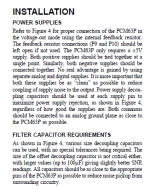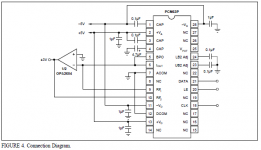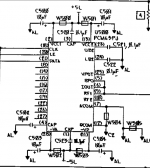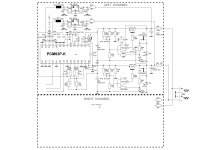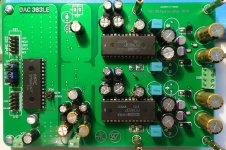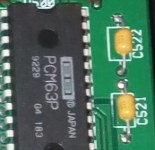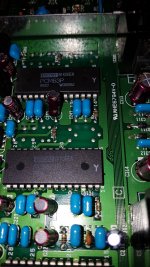Hi all,
I am "refreshing" an ADCOM GDA-600 which uses dual PCM63P DAC chips, and seeking advice regarding the decoupling capacitors.
I am familiar with the various mod threads out there. Part of this project is learning about DAC construction so I'd rather not follow those blindly.
I've read the PCM63 datasheet and have the schematic (relevant parts attached).
On the GDA-600, 10uF caps are used on pins 2,11,13,28 (analog and digital power supplies) and pin 4 (offset decoupling capacitor).
A few questions:
1) In the attached snippet, it is mentioned that "larger values (up to 100uF) give slightly better SNR". It wasn't clear to me if they are referring only to pins 1,3,4, or also to the power supplies decoupling caps.
2) Is there value in increasing the capacitance for the PS decoupling caps?
3) What are good types of capacitors for this application? Is this case a good candidate for "audio" capacitors such as ELNA Silmic II, Nichicon UES or UKZ, or rather low ESR caps such as Panasonic FC, etc?
Thanks!
I am "refreshing" an ADCOM GDA-600 which uses dual PCM63P DAC chips, and seeking advice regarding the decoupling capacitors.
I am familiar with the various mod threads out there. Part of this project is learning about DAC construction so I'd rather not follow those blindly.
I've read the PCM63 datasheet and have the schematic (relevant parts attached).
On the GDA-600, 10uF caps are used on pins 2,11,13,28 (analog and digital power supplies) and pin 4 (offset decoupling capacitor).
A few questions:
1) In the attached snippet, it is mentioned that "larger values (up to 100uF) give slightly better SNR". It wasn't clear to me if they are referring only to pins 1,3,4, or also to the power supplies decoupling caps.
2) Is there value in increasing the capacitance for the PS decoupling caps?
3) What are good types of capacitors for this application? Is this case a good candidate for "audio" capacitors such as ELNA Silmic II, Nichicon UES or UKZ, or rather low ESR caps such as Panasonic FC, etc?
Thanks!
Attachments
I would avoid the low esr types on the analog side, the digital side may well benefit from lower esr parts, as long as they aren’t on the same power rail.
You may get better bass response using the larger value caps, or it may not make much difference in that particular circuit.
You may get better bass response using the larger value caps, or it may not make much difference in that particular circuit.
as long as they aren’t on the same power rail.
In this case they share the same supply...
From one russian site...
Thanks! if I'm not mistaken it looks like they used 100uF, which is inline with the datasheet.
I think I'll increase the value up to that, as long as the new cap physically fits in the old position.
The DAC currently has general purpose Nichicon VX caps in those positions, not sure which to go with for replacement.
Hello,
Rubycon PMLCAP and KEMET KO-CAP(Polymer tantalium) are supreme for DAC reference capacitor.
But PMLCAP is very expencive outside Japan.
If you intrested PMLCAP, I recommend capacitor kit of PMLCAP.
1189-4323-KIT Rubycon | Kits | DigiKey
Panasonic ECHU is similar to PMLCAP (very thin layered film capacitor), but smaller capacity only.
I recommend KO-CAP plus paralleled with PMLCAP (or ECHU) 0.1uF.
I tested this combination for PCM1792, I got better sound quality.
Rubycon PMLCAP and KEMET KO-CAP(Polymer tantalium) are supreme for DAC reference capacitor.
But PMLCAP is very expencive outside Japan.
If you intrested PMLCAP, I recommend capacitor kit of PMLCAP.
1189-4323-KIT Rubycon | Kits | DigiKey
Panasonic ECHU is similar to PMLCAP (very thin layered film capacitor), but smaller capacity only.
I recommend KO-CAP plus paralleled with PMLCAP (or ECHU) 0.1uF.
I tested this combination for PCM1792, I got better sound quality.
I not have PCM63.
But I think, can be used bipolar cap for decoupling otherwise Pin 23, 24.
Pin 23 and 24 is used for upper 2bit adjustment, then this section is suitable for nonpolar cap.
"larger values" capacitor is generally has lower frequency properties.
Then combined multiple capacitors.
Effective Use of Decoupling (Bypass) Capacitors Point 1 | Basic Knowledge | ROHM TECH WEB: Technical Information Site of Power Supply Design
But I think, can be used bipolar cap for decoupling otherwise Pin 23, 24.
Pin 23 and 24 is used for upper 2bit adjustment, then this section is suitable for nonpolar cap.
"larger values" capacitor is generally has lower frequency properties.
Then combined multiple capacitors.
Effective Use of Decoupling (Bypass) Capacitors Point 1 | Basic Knowledge | ROHM TECH WEB: Technical Information Site of Power Supply Design
But I think, can be used bipolar cap for decoupling otherwise Pin 23, 24.
Pin 23 and 24 is used for upper 2bit adjustment, then this section is suitable for nonpolar cap.
Pins 23,24 (C521, C522) in the schematic are 0.1uF.
They seem to be MLCC, or other ceramic type?
Rubycon PMLCAP and KEMET KO-CAP(Polymer tantalium) are supreme for DAC reference capacitor.
Are you referring to Pin 3, "Reference Decoupling Capacitor?
I am assuming this advice does not apply for the PS decoupling caps, on P11, P13, P28 and P2
Attachments
I seem that cap is MLCC.They seem to be MLCC, or other ceramic type?
I think, ECHU would be better than MLCC.
Page 3 of PCM63P datasheet:Are you referring to Pin 3, "Reference Decoupling Capacitor?
I am assuming this advice does not apply for the PS decoupling caps, on P11, P13, P28 and P2
Pin1: Servo amp Decoupling Capacitor
Pin3: Reference Decoupling Capacitor
Pin4: Offset Decoupling Capacitor
These capacitors are would be susceptible to sound quality of capacitor.
I seem that cap is MLCC.
I think, ECHU would be better than MLCC.
Page 3 of PCM63P datasheet:
Pin1: Servo amp Decoupling Capacitor
Pin3: Reference Decoupling Capacitor
Pin4: Offset Decoupling Capacitor
These capacitors are would be susceptible to sound quality of capacitor.
They are all critical with PCM63.
I totally agree WRT replacing MLCC caps on any non-digital DAC pins.
As I have stated elsewhere, you can disconnect the BPO track from DAC OP and use a (from memory) 2mA CCS for sound improvement.
TCD
Which type would you recommend for Pins 1,3,4?
The types recommended earlier in the thread seem to be SMD only
They are a good place to start. Get used to SMD
I would avoid the low esr types on the analog side, the digital side may well benefit from lower esr parts, as long as they aren’t on the same power rail.
You may get better bass response using the larger value caps, or it may not make much difference in that particular circuit.
Last edited:
Hello, diyiggy.
Best electrolytic capacitors
Lifespan of Black Gate caps ?
Their sound overcomes BlackGate.
I also tested TDK (EPCOS) and Elna, they are "slightly" better than Panasonic ZA.
I tested Hybrid caps and it became my favorite.I like the choice of the picture that looks like Black Gate for the lytics.
Best electrolytic capacitors
Lifespan of Black Gate caps ?
Their sound overcomes BlackGate.
I also tested TDK (EPCOS) and Elna, they are "slightly" better than Panasonic ZA.
Agreed,
Have my receips as well, made better than E super caps with two Black Gate N... though often the BG can help...
However, this is an equilibrium with the circuity and the rest from my experience... I don't like silmic Ii for instance for decoupling, but it can be needed sometimes, though like them as coupling cap sometimes, and so on....all is about the tipology and the over hifi devices around...now people eq though so caps game is disseapering.
Have my receips as well, made better than E super caps with two Black Gate N... though often the BG can help...
However, this is an equilibrium with the circuity and the rest from my experience... I don't like silmic Ii for instance for decoupling, but it can be needed sometimes, though like them as coupling cap sometimes, and so on....all is about the tipology and the over hifi devices around...now people eq though so caps game is disseapering.
Last edited:
As I have stated elsewhere, you can disconnect the BPO track from DAC OP and use a (from memory) 2mA CCS for sound improvement.
TCD
Hi, I know it is an old dac chip, but could you elaborate a bit more for the less expert (like myself
 )?
)?Thanks a lot,
Stefano
Hi, I know it is an old dac chip, but could you elaborate a bit more for the less expert (like myself)?
Thanks a lot,
Stefano
Have you downloaded data sheet?
TCD
Hi, I know it is an old dac chip, but could you elaborate a bit more for the less expert (like myself)?
As @Terry has suggested its a good idea to study the datasheets. If you compare for example PCM63 with PCM1702 (its immediate successor) you'll notice on the diagram on the first page that there are three logical blocks contributing to the output current. Only on the PCM63 is the lowest of the three blocks able to be disconnected (pin5). That's a considerable advantage in flexibility for the PCM63 as against its successors (PCM170X).
- Home
- Source & Line
- Digital Line Level
- PCM63P decoupling capacitors
